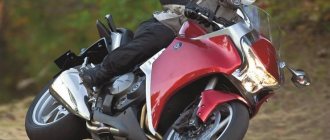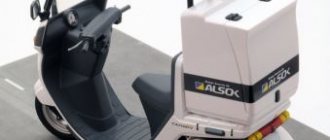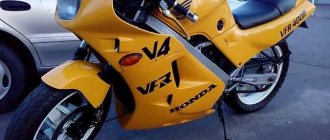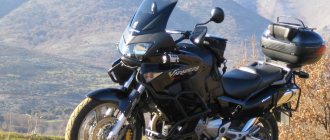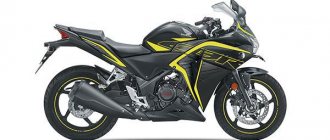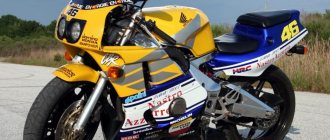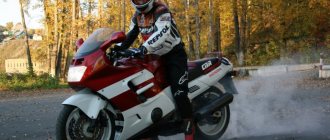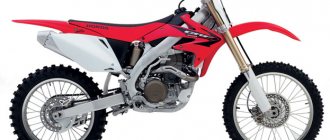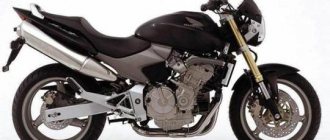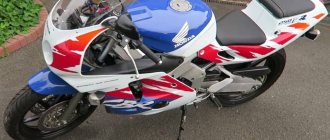The logical continuation of the VFR1200F model, which Honda offered the user in 2008, was to become a dual-purpose model. This is exactly the sequence that the concern proposed several years earlier, first releasing the VFR800F model, and then, based on it, the vfr800x crossrunner .
The developers did not disappoint expectations and in 2010 the touring enduro Honda VFR1200X Crosstourer was presented to the public. According to the thumbnail diagram, the engine settings are changed, reducing the maximum power, but increasing traction at the bottom, a new instrument panel is tested, and two years later the motorcycle goes into production.
As was previously the case, the F model becomes a sport tourer, the X model a tourist and SUV.
Features of Honda VFR1200X
An unexpected and bold decision was the installation of a robotic gearbox, which immediately raised the bar for the popularity of the new motorcycle.
Owners of touring enduros are real conservatives who are wary of any innovations. Therefore, it is worth paying tribute to Honda for taking the risk of adding a DCT automatic transmission to its model line.
Conceived as a response to the release of the Yamaha Super Tenere, the Crosstourer managed to significantly advance its position in both the export and Japanese markets.
The production of the model continues, moreover, some parts from it were transferred without significant changes to its younger sister - vfr800x. In 2021, the younger one is finally consigned to history, giving the older one room for sales.
Brief history of the model
- 2012 - start of production and sales.
Model
: Honda VFR1200X Crosstourer;
Honda VFR1200XD Crosstourer (DCT) (all regions). Factory designation
: VFR1200XC, VFR1200XDC.
- 2013 - no significant changes.
Model
: Honda VFR1200X Crosstourer;
Honda VFR1200XD Crosstourer (DCT) (all regions). Factory designation
: VFR1200XD, VFR1200XDD.
- 2014 - the Honda VFR1200X model has undergone minor changes, a 3-speed HSTC (Honda Selectable Torque Control) system has appeared (before the advent of HSTC, the motorcycle was equipped with a simple switchable traction control), turn signals with an auto-off function, and the seat has been slightly changed.
Model
: Honda VFR1200X Crosstourer;
Honda VFR1200XD Crosstourer (DCT) (all regions). Factory designation
: VFR1200XE, VFR1200XDE.
- 2015 - no significant changes.
Model
: Honda VFR1200X Crosstourer;
Honda VFR1200XD Crosstourer (DCT) (all regions). Factory designation
: VFR1200XF, VFR1200XDF.
- 2016 - the engine began to comply with the Euro-4 standard, a 12V cigarette lighter socket appeared, a lever for changing the height/tilt of the windshield appeared near the dashboard, mode S (on the DCT box) now has 3 modes.
Model
: Honda VFR1200X Crosstourer;
Honda VFR1200XD Crosstourer (DCT) (all regions). Factory designation
: VFR1200XG, VFR1200XDG.
- 2017 - no significant changes.
Model
: Honda VFR1200X Crosstourer;
Honda VFR1200XD Crosstourer (DCT) (all regions). Factory designation
: VFR1200XH, VFR1200XDH.
- 2018 is the last year of production.
Model
: Honda VFR1200X Crosstourer;
Honda VFR1200XD Crosstourer (DCT) (all regions). Factory designation
: VFR1200XJ, VFR1200XDJ.
Specifications
By tradition, a retuned engine from the prototype, version F, was installed on the motorcycle. It also has 4 cylinders, 4 strokes.
The pistons are V-shaped, but the angle between them has been reduced to 760 . This solution created a loss of overall power, but made it possible to achieve good traction at low and medium speeds - the operating ranges for enduro models.
The V-shaped engine can be called “bottomless” - it is absolutely indifferent to it whether you are driving alone around the city or overtaking a truck on the highway with a full load.
The final x-ki had the following parameters:
- working volume - 1238 cm3;
- power - 129 hp;
- number of valves - 16;
- cylinders - 4;
- cooling - liquid;
- fuel supply - injector;
- ignition - transistor;
- start - electric starter;
- fuel tank - 21 l.
Transmission and clutch
The gearbox on the bike is 6-speed. By default, it is configured for robotic gear shifting (automatic transmission).
But the user has the opportunity to turn off the robot at any time and switch to a standard mechanical system.
Manual downshifting is initiated by the minus key on the left handlebar. There are also a lot of buttons that take some getting used to.
The robot offers two modes:
- S (sport) , when the gears are changed instantly, the revolutions are barely allowed.
- D(dual) . In this mode, the bike “thinks” that we are driving off-road and the speed will constantly change, so up gears are engaged with some delay , and down gears are engaged almost like in a sport.
Switching between modes N, D and S occurs using the buttons on the right handle.
Known to Honda users, the attention to detail and concern for safety made it possible to create the ideal robotic box. The mechanics are turned on only to check whether it works.
- The main drive is carried out by a cardan shaft .
- Multi-plate clutch, oil bath.
- Power transmission from the handle is via a hydraulic line .
Brakes
Front brakes.
Rear brakes.
With such parameters of the engine and gearbox, the bike received appropriate brakes. Drive - hydraulic main. Type - disk.
Front brakes:
- number of disks - 2;
- diameter - 310 mm;
- support - 3-piston.
Rear brakes:
- number of disks - 1;
- diameter - 256 mm;
- support - 3-piston.
Models sent to European countries receive combi brakes + ABS (hence the need for a 3rd piston).
According to the developers, in recent years the solution has been used on all bikes of this model. Earlier ones can be additionally installed in authorized services.
I bring to your attention a translation of an article in English from the Visordown magazine website, published on February 17, 2012 (full text is under the cut)
Made to Ride in Comfort Original Publication Date: February 17, 2012 Author: Mark Forsyth
The Japanese attach utmost importance to manners, as if imbibing them with mother's milk. Therefore, when at the presentation of the Crosstourer model, Honda representatives limited themselves to a general phrase that their new creation exactly reflects customer requests, no further explanation was needed - however, none was forthcoming.
The average age of modern motorcyclists is steadily creeping up - no matter how sad it is to admit, we are getting old, graying, going bald - in a word, we are changing. Together with us, our ideas about what a motorcycle should really be are changing. Well, since Japanese manners do not allow calling the target audience a bunch of decrepit old farts who can barely control their natural urges, Honda marketers had to invent a more hopeful legend.
And so they are inspired to report that today a great many bikers have begun to value something else besides the technical superiority of their motorcycle over its competitors. That they no longer want to cower like a fetus behind the windshield pretending to be a MotoGP pilot. They, you see, no longer need to prove anything to anyone. Can you imagine? This is what I call political correctness! So, motorcyclists of our generation, suffering from senile arthritis, myopia and constipation, need another motorcycle - a two-wheeled crossover, an analogue of a parquet SUV, but with the appearance of a harsh mud conqueror. It’s just a pity that the guys from BMW figured this out much, much earlier.
In addition, the calling card of a real BMW is a boxer engine with cylinders sticking out in different directions. Yamaha Super Tenere is another “deuce”, only parallel, along with Ducati’s Multistrada. All these models have won the hearts of many fans, but what if you desperately want to prove to the whole world that you can count to more than just two?
Then meet: the new Honda with a V-shaped “four”, which the creators compare with a premium SUV – a kind of two-wheeled Range Rover Sport V8, which is at least twice as cool as the four-cylinder Jeep Grand Cherokee.
The engine and frame donor for the new model was the VFR1200, but not without significant changes. No, the aluminum alloy space frame remains intact, but the engineers have worked hard on the engine to give it a two-cylinder character in the lower rev range. Some may think that throttling the engine is wrong, but they achieved their goal.
Despite having exactly the same proprietary Unicam cylinder heads as the donor (except for a smoother cam profile), Honda's engineers were able to extract many more lb-ft in the low end just by restricting the intake and exhaust ports. The diameter of the exhaust manifold pipes is 10 mm smaller (for VFR1200 - 28 mm), and the L-shaped funnels of the intake tract are 40 mm longer and 4 mm thinner. All these changes to the intake and exhaust, the cam profile and the settings of the electronic control unit (ECU) that commands the injector system have given the engine a completely different character compared to the original, and the results are so amazing that you can’t help but wonder: why didn’t the Japanese make it like this in the first place? From idle you immediately have a generous supply of torque at your disposal. Want to test your hands? Just stand up on the footpegs and open the gas wide - the traction in the first three thousand will pleasantly surprise you.
The remaining changes compared to the donor VFR1200 are not so obvious, but there are plenty of them: the suspension travel is increased, new stylized plastic panels are installed, the tank volume is increased (21 l), and the wide and high steering wheel, coupled with a flat and soft seat, gives the VFR a visual resemblance to the conqueror mud. Wide alloy wheels not only look great, but also allow the use of tubeless tires thanks to the side-mounted spokes to the rim. However, the VFR1200's dry weight of 265 kg makes it the same SUV as a Range Rover Sport on 22-inch wheels. So, away with illusions: before us is a road motorcycle, endowed with incredible comfort, which sometimes borders on the absurd.
How is it running? First, I got a version with a manual transmission, equipped with optional saddlebags: a top and two side cases. The top case is equipped with a soft insert on a snake in the style of the pop-up roof of a VW Pop-Top Camper, which allows you to place an integral helmet in size XL. Of course, like any solid rectangular-shaped objects, panniers still affect handling. At speeds above 160 km/h there is no bumpiness or shimmy, but the motorcycle subtly hints at the possibility of their appearance at any moment. For these reasons, the top speed is electronically limited to 210 km/h. Well, in any case, it is cheaper than compensation for damage to those who like to ride like a breeze. If you do not take into account the shocking width of the motorcycle with side panniers, the presence of luggage is felt only in long high-speed turns and at high speed, and the considerable curb weight is practically not noticeable either in shifts or during vigorous acceleration or braking - especially if you act smoothly. A more energetic driving style on the edge of tire grip will quickly reveal its true weight, but take my word for it: to get beyond the comfort zone, you will have to exceed the permitted speed limit twice as much. The soft and long-travel suspension perfectly smooths out bumps and potholes, turning the ride into a complete pleasure. However, the most striking impression is the implementation of torque. This engine is constantly ready to deliver traction without fiddling with the gearbox and constantly monitoring the speed. For most of the 180 km journey I barely touched the gear lever. To quickly, smoothly, and most importantly, with pleasure, drive a winding ten-mile section, it was enough to simply dose the gas. With plenty of low-end torque, your ride quickly becomes smooth and effortless. The revs peak at 9,500 rpm, leaving plenty of headroom in each gear, especially since there's plenty of power lurking in the mid- and top-end of the range.
The upright seating position also contributes to a comfortable feeling - especially when driving on an unfamiliar road, trying to keep up with someone who is sparing no effort. Not only can you look over a wall, fence or car in long turns, but you can also spot danger on the way out faster.
The seat was a real revelation for me. If on the VFR1200 the tank was constantly resting on the crotch, on the Crossrunner - well, again, I just can’t get used to the word CROSSTOURER - both buttocks rest evenly on a soft, slightly springy base, while the hands rest relaxed on the high, widely spaced handlebar grips. The mirrors show everything except your shoulders and elbows, and the footrests are moved significantly forward. Rarely does a motorcycle pamper the driver so much.
In addition to the usual information, the new digital instrument panel displays the current gear, remaining fuel, range before stopping, as well as instantaneous and average consumption. After driving in the “all money” mode, the on-board computer showed 7.8 l/100 km, but if I had filled it from my own pocket, I would have been able to get within 5.5 l/100 km. In response to criticism from VFR1200 owners, the fuel tank capacity was increased to 21.5 liters.
Similar to the 2012 VFR1200, the Crosstourer uses a remote link between the throttle and throttle grip. Using a pair of wheel speed sensors, Honda engineers managed to create an amazingly simple, but incredibly effective traction control system. When the system detects a discrepancy between the front and rear wheel speeds of more than 25%, it first gently closes the throttle valves and then limits the fuel supply as necessary. I had a chance to test (or rather torment) this system on generously salted asphalt and gravel, and I was quite pleased with the gentleness of the intervention, after which it takes a few seconds to return to its original state. In reverse mode, the system also effectively fights the lifting of the front wheel into the spark plug. Annoys? Just press the desired button to turn off.
The fuel injection system and electronic throttle make it easy to implement cruise control. I asked the corresponding question to the Head of Major Projects, Mr. Hasegawa, on behalf of one of the users of our forum, and this is what I heard: “This function has already been partially implemented: with the gas fully open at a speed of 210 km/h, the ECU independently adjusts the throttle operation to maintain this speed while driving uphill and downhill." Thus, full-fledged cruise control is not yet available on the Crosstourer, but will certainly appear in the future.
The motorcycle is equipped with a time-tested ABS system, which is included as standard equipment. It would hardly be wise to test it on asphalt on purpose, but I managed to feel its presence on gravel. What can I say – it just works. However, this system inspires complete confidence after last year's test of a Fireblade with an identical system: the brakes work clearly and effectively.
No matter what anyone says, I liked this motorcycle. Despite my fondness for the VFR1200 due to its personality matching my riding style, it's safe to say that the Crosstourer appeals to a much wider audience. This motorcycle successfully combines the highest comfort, excellent potential for carrying luggage and a high-torque engine that runs like silk and delights the ear with a rich growl. Sure, some will find it too heavy, but my best advice is to just ride it! It may be heavier on paper than the BMW GS, but in reality (especially during slow turns and parking maneuvers) its true weight is not felt at all.
The bike is offered in four color options - red, silver, black and white, with a host of optional equipment including... ahem, a center stand. Here I have to make a nod to the glass manufacturers: despite the fact that the Crosstourer is equipped with a standard two-position windshield, it is categorically insufficient even in the upper position.
I believe that I managed to find a motorcycle that I would like to finish out this year on, but do not forget that I am 46 - and where did my copper miracle bracelet and crossword puzzle book go?!
Driving characteristics, fuel consumption
The motorcycle feels confident on winding roads, taking tight turns with confidence and predictability.
Despite the reduced power, the maximum speed indicated in the documents for the motorcycle is 200 km/h . According to users, this speed can be achieved with fully loaded cases and a second number (if you want to lose the first or second). We managed to accelerate a clean bike on a good autobahn to 235 km/h .
Fuel consumption
Fuel consumption is modest (by class standards). For 100 km, a fully functional bike at cruising speed ( ~150 km/h ) will require only 5.5 liters .
Acceleration to hundreds
The acceleration of up to 100 km indicated in the documents will allow you to compete with many sports - 4 seconds.
Dimensions and weight
It’s interesting that installing a robotic gearbox changed the weight by only 10 kg:
- Curb weight without robot (on mechanics) - 275 kg .
- Curb weight with automatic transmission - 285 kg .
The overall dimensions changed only once, when the manufacturer decided to offer the bike in Japanese markets. The changes affected the height of the saddle and, accordingly, the ground clearance. Thus, even when casting the frame, it was known where the motorcycle would go from the factory.
- 2285 mm - length;
- 915 - width;
- 1335 — in height (according to mirrors);
- Wheelbase - 1595 mm.
Seat height:
- for the Japanese version - 810 mm;
- for all others - 850 mm.
The clearance of the Japanese version is 165 mm, the rest - 180 mm.
For whom is it intended?
According to the developers, the motorcycle was designed for a person of average height. But if you adjust the height of the footpegs and adjust the steering wheel, even a tall biker will be able to ride comfortably.
The seating position in the saddle is classic endura, designed for standing riding.
If we take into account the presence of the “Japanese” version with a lower saddle height, even a short person can buy a motorcycle. To a tricky question from journalists: are developers classified as low? biker girls, was the answer - if she can cope with a machine weighing almost 300 kg - why not. With a large number of orders, they are ready to think about releasing a Limited Edition - a little lighter.
Appearance
This is probably the main advantage of the model compared to classmates from different eras. The Honda VFR 1200X Cross Tourer is beautiful, there's no doubt about it. Neat spoked wheels, a chrome exhaust pipe, a smoothly rising but high tank - all this is harmoniously combined and makes the motorcycle aesthetically pleasing and modern.
Of course, if you don't like the new trends, you won't like this bike either. But here it comes down to the peculiarities of the aesthetic worldview, and the modernity of the lines cannot be counted among the disadvantages of the car. Objectively, this is only a plus, because it makes it easier to adjust the filling to the body and make the motorcycle more modern and technologically advanced.
Competitors
When asked about the competitors of the developers, in addition to Super Tenere from Yamaha, they also name the German goose - BMW R1200GS and the Japanese Versys 1000 from Kawasaki.
BMW R1200GS.
Kawasaki Versys 1000.
Users answer the question about competitors like this:
- crosstourer is better than super tenere in terms of fuel consumption and ergonomics;
- it is better than the German in terms of weight and driving performance;
- better than the ducati multistrada 1200 because it rarely breaks;
- and finally, Kawasaki is better because it’s Honda.
Honda
A video in which the author reads data from the brochure to the audience, tells his feelings about how he sat down on the bike, theorizes, and makes quite a few mistakes - a review, such a review. Just a review for everyone. In order. Firstly, the bike is actually called the VFR1200XD Crosstourer. Also on websites they sometimes write VFR1200X DCT. But there are no “VFR1200X Auto”, and never have been. I don’t know where the domestic brainiacs from Honda Motor Rus came up with this name, but it is incorrect. Secondly, this motorcycle, like all its direct competitors (BMW R1200GS/GSA, Yamaha XT1200Z/ZE, Triumph Tiger Explorer, Moto Guzzi Stelvio), is not and has never been a touring bike. These are all tourist SUVs. Or adventure bikes, in Pindosian. Everything here is extremely simple: if an adventure bike has a front wheel less than 21 inches, then it is a SUV. Regardless of how hard the manufacturer tries to hide it, hanging the bike with all sorts of arches and bells and whistles. It's still a SUV, just hung up. R1200GSA, XT1200Z Worldcrosser, Ducati Multistarda Enduro - these are all still SUVs, just with off-road styling. Real tourenduros always have a 21-inch front wheel, and nothing else. Wheel size is, of course, not the only feature that makes a motorcycle a touring bike. There are, of course, a lot of such traits and qualities. It’s just that the size of the front wheel is the most noticeable and obvious feature of a tourendura, allowing you to quickly distinguish it from SUVs. If we see an adventure bike with a front end of less than 21 inches, then we have a SUV. If we see an adventure bike with a 21-inch front end, then this is most likely a tourenduro. With rare exceptions in the form of a pair of ancient SUVs with enduronic wheels (for example, Kawasaki KLE500). But among modern technology there are no such exceptions.
But we are slightly distracted from the original topic of conversation - the Honda VFR1200XD Crosstourer. In short, this bike is GREAT in almost every way. An excellent, powerful, peppy, and cheerful engine with absolutely locomotive traction throughout the entire rev range from idle to redline makes the bike the fastest and fastest in the class of cardan adventure bikes. If you unscrew the throttle all the way, the speedometer exceeds 200 with frightening speed. None of the Crosstourer's competitors has such dynamics - neither Gus, nor, especially, SuTenur. At the same time, the Crosstourer’s engine hardly vibrates, which, again, distinguishes it favorably from the Goose and SuTeneur: they shake, be healthy. Especially the Sou Teneur. The ergonomics (handlebar-saddle-pegs triangle) of the Crosstourer are simply standard - everything is as comfortable as possible. When you sit on it, you get the impression that the bike was specially made for you. Moreover, this feeling occurs both among riders with a height of 170-175 cm, and among those whom nature has awarded with a height of 185-190 cm. The wind protection with high glass is also wonderful - journalists wrote that it is better than that of SuTeneur and Goose. Although for me personally, with my 175-176 cm, it was enough for all three. The handling is excellent - the motor steers simply by the power of thought. It’s not for nothing that the owners themselves call it great. The bike also hides its weight very well: I have no idea where they hid 275-285 kg, because on the go it feels like 150-160 kg maximum. Like enduro scabies. This is achieved due to excellent mass centralization and a very low center of gravity. You know the phrase “raise your feet and the bike stands on its own”? This is just about the Crosstourer. However, in fairness, it is worth noting that Gus and SuTeneur steer and hide their weight no worse, even though their CG is higher.
The Crosstourer suspensions also work great: they provide super light and precise handling, excellent directional stability, and at the same time absorb any road irregularities very softly and effectively. Asphalt joints, holes, bumps, convex markings - on the Crosstourer all this is not felt at all. It's as if it doesn't exist. The moto doesn’t give up on dirt roads either - it goes just as smoothly, confidently, and stably. The Crosstourer’s reliability is also excellent: an extremely reliable and durable bike. Previously, however, he had one very serious problem, which he inherited from the VFR1200F: defective cardan shafts. But now this problem has already been solved, because... At the end of last year, Honda launched a worldwide recall campaign on cardan shafts - and all Vyfer 1200s from previous years of production (both F and Crosstourers) will receive the new type of cardan shafts absolutely free. Otherwise, everything about the Crosstourer goes without a hitch - that’s why it is MUCH more reliable than BMW, Triumph, and Moto Guzzi, which sometimes simply fall apart on the move (and not only on the move). Well, this whole composition is completed by a real diamond in the form of a DCT transmission: a box that combines operating speed even greater than that of a manual transmission with the softness and smoothness of a modern automatic transmission. This box is just fabulously good! The squeezing of the clutch, the clatter of the gearbox, the left hand numb after an hour's drive in traffic jams, jerks and misfires when switching, false neutrals, stalling at a traffic light because you were lost in thought and missed turning on green - forget all this like a bad dream: with DCT this is all a thing of the past. Forever. After it, you most likely simply won’t want to switch back to outdated primitive mechanics. I personally didn’t want it at all. But I had to, because I can’t even afford a Crosstourer yet. And this feature (DCT transmission) makes the Crosstourer an absolutely unique motorcycle, which has no analogues in principle.
Conclusion: The crosstourer is an extremely successful and pleasant motorcycle in all aspects. It is definitely the best in the class of cardan adventure bikes. Propellers, of course, will not agree with this, but this one is true. Well, personally, the opinion of blue and white fanboys has never bothered me and does not bother me. Which is what I recommend to you. And don’t listen to armchair theorists who have never ridden this motorcycle themselves, but condemn it because... they don't like ugly numbers in brochures: these guys are just pathetic.
All the best.
Flaws
Users note only one downside to the bike - the robot’s modes are tight.
If the user prefers to drive in a different gear than the robot suggests, you need to switch to mechanics. Returning to the robot will engage an inconvenient gear. But there is also a workaround - click the modes when you get into a traffic jam. When driving between rows, steer in S, on an open road - in D.
And also note the short front wing . If you attach a mudguard from an old tire to it, or extend the rear part, the filter in the radiator will have to be changed two to three times less often.
Advantages
On the move, the Crosstourer feels surprisingly light compared to similar models from competing companies.
- Acceleration dynamics.
- Good energy-intensive footpegs that dampen even hints of vibration.
- A comfortable saddle allows both driver and passenger to ride long distances without any problems.
- Reliability.
- Moderate fuel consumption.
What do the owners say?
Judging by the reviews, the car is perfect for conquering routes of thousands of kilometers. Not only road motorcycles, but even sports tourists are often unable to cope with such a task. This machine does not often require maintenance, which makes the task easier and reduces risks.
IMPORTANT! The good thing about the motorcycle is that it’s easy to get spare parts for it now. However, repairs somewhere in an unknown workshop in another country are not the best solution. So it’s better to avoid such a situation and check the bike in advance before going on a long journey. And if you suspect a malfunction, it is better to re-diagnosis.
The visibility through the mirrors is praised, as is the seating comfort. Not everyone likes the dashboard, but there are no objective complaints about it. According to the description of those who have been driving this bike for a long time, the machine is perfect for people who want to purchase a beautiful and practical touring enduro.
The VFR 1200X Crosstourer isn't the best model in its class, but it's still decent. And one of its main advantages is modernity. No matter how good the same old Africa Twin is, if something happens to the motorcycle, repairing it will be problematic. So, if the question arises about buying an enduro tourist, you should think about this model.
